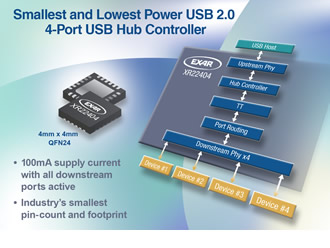Low power USB 2.0 hubs allow self-powered operation
A family of USB 2.0 hubs that consume the least amount of power and require the smallest real-estate footprint in the industry have been announced by Exar Corporation. The XR22404 and XR22417 are designed for applications where power consumption and board space are a concern such as docking stations, point-of-sale terminals, USB port expansion, test instrumentation, factory automation and other industrial applications.
The XR22404 is a cost-effective USB 2.0 4-port hub controller that can be configured for downstream device charging and supports USB Battery Charging Specification 1.1 and 1.2. The XR22404 operates from either 3.3 or 5V supplies, allowing bus or self-powered operation without an external LDO. Available in a 4x4mm, 24-pin QFN package, the XR22404 is the smallest USB 2.0 4-port hub controller on the market. It is also available in a 28-pin SSOP for less space-constrained applications.
The XR22417 is a USB 2.0 7-port hub controller that utilises Multiple Transaction Translators (MTT) for the highest possible bandwidth. Like the 4-port device in the family, the XR22417 benefits from design optimisation that minimises power, size and cost to meet the challenging constraints facing connectivity and interface designers. The XR22417 is available in a 64-pin LQFP package as well as a smaller 48-pin LQFP.

The XR22404 and XR22417 are compatible with standard software drivers and include LED indicators to simplify implementation. Both controllers attach to upstream ports at hi-speed (480Mbps) or full-speed (12Mbps). The downstream PHYs support hi-speed, full-speed and low-speed (1.5Mbps) on each port.
“The XR224xx USB hub controllers offer a combination of low power, small size and low cost that is unmatched in the industry,” said Colin Earle, Senior Director of Product Marketing at Exar. “System designers using these devices can easily add USB connectivity and stay within the stringent size, power and cost requirements of leading edge computing and industrial applications.”






